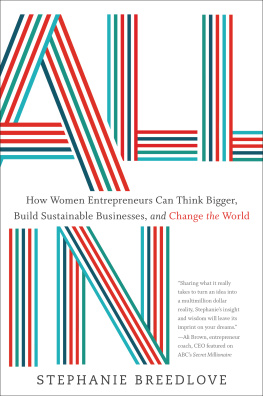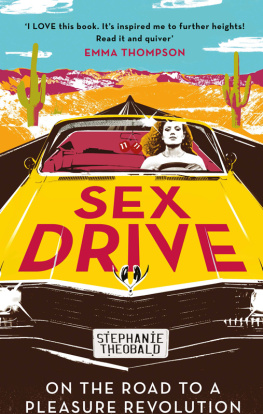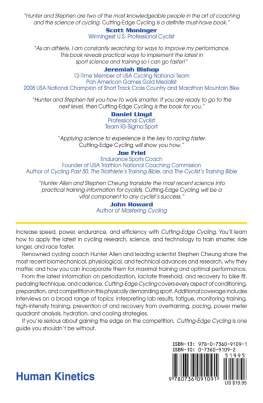Stephanie A. Wisner - Building Backwards to Biotech: the Power of Entrepreneurship to Drive Cutting-Edge Science to Market
Here you can read online Stephanie A. Wisner - Building Backwards to Biotech: the Power of Entrepreneurship to Drive Cutting-Edge Science to Market full text of the book (entire story) in english for free. Download pdf and epub, get meaning, cover and reviews about this ebook. year: 2022, publisher: New Degree Press, genre: Romance novel. Description of the work, (preface) as well as reviews are available. Best literature library LitArk.com created for fans of good reading and offers a wide selection of genres:
Romance novel
Science fiction
Adventure
Detective
Science
History
Home and family
Prose
Art
Politics
Computer
Non-fiction
Religion
Business
Children
Humor
Choose a favorite category and find really read worthwhile books. Enjoy immersion in the world of imagination, feel the emotions of the characters or learn something new for yourself, make an fascinating discovery.

- Book:Building Backwards to Biotech: the Power of Entrepreneurship to Drive Cutting-Edge Science to Market
- Author:
- Publisher:New Degree Press
- Genre:
- Year:2022
- Rating:5 / 5
- Favourites:Add to favourites
- Your mark:
- 100
- 1
- 2
- 3
- 4
- 5
Building Backwards to Biotech: the Power of Entrepreneurship to Drive Cutting-Edge Science to Market: summary, description and annotation
We offer to read an annotation, description, summary or preface (depends on what the author of the book "Building Backwards to Biotech: the Power of Entrepreneurship to Drive Cutting-Edge Science to Market" wrote himself). If you haven't found the necessary information about the book — write in the comments, we will try to find it.
Stephanie A. Wisner: author's other books
Who wrote Building Backwards to Biotech: the Power of Entrepreneurship to Drive Cutting-Edge Science to Market? Find out the surname, the name of the author of the book and a list of all author's works by series.
Building Backwards to Biotech: the Power of Entrepreneurship to Drive Cutting-Edge Science to Market — read online for free the complete book (whole text) full work
Below is the text of the book, divided by pages. System saving the place of the last page read, allows you to conveniently read the book "Building Backwards to Biotech: the Power of Entrepreneurship to Drive Cutting-Edge Science to Market" online for free, without having to search again every time where you left off. Put a bookmark, and you can go to the page where you finished reading at any time.
Font size:
Interval:
Bookmark:
Building Backwards to Biotech
The Power of Entrepreneurship to Drive Cutting-Edge Science to Market
Stephanie A. Wisner

New Degree Press
Copyright 2022 Stephanie A. Wisner
All rightsreserved.
Building Backwards to Biotech
The Power of Entrepreneurship to Drive Cutting-Edge Science to Market
ISBN
979-8-88504-048-8 Paperback
979-8-88504-049-5 Kindle Ebook
979-8-88504-050-1 Ebook
For my parents, who believed in me before any words of my story were ever written. I loveyou.
For my mentors, who supported me, invested in me, and took a chance on me. Particularly, Keith Crandell, Jacob Glanville, Martin Sanders, J. David Gangemi, Kristina Burow, Ben Cravatt, and CherylFuller.
I stood alone in the hospital bathroom, bent over the sink, trying to catch my breath. I replayed the words the doctor had said to me only moments ago after the door had clicked safely shut behind our last patient:
Theres nothing else we can do forher.
When I took this job as a medical scribe in primary care, I was fully aware that there were plenty of diseases for which there were no cures. I just hadnt anticipated the frequency with which I would hear these words, nor my difficulty accepting the reality of them.
This patient was a young woman only a few years older than me. She had inoperable cancer and had undergone the standard chemotherapy and radiation treatments, but neither prevented the cancer from metastasizing. Her oncologists notes suggested we speak to her about palliative care and other end-of-life options.
This patient did not say much. Instead, she cried big, choking sobs in front of usthe kind I had only ever let out behind closed doors. In response, I did my jobthe only thing I could do. Patient presents with grief reaction, I wrote in her chart.
I had, at this point, witnessed many such cases: cases where, at some point, the standard of care protocols we followed had exhausted treatment options. The only remaining guidelines pertained to helping a patient to die comfortably.
One oncologist I worked with specialized in liver cancer, a particularly terrible disease for which existing medicines were largely ineffective. Ive become really good at walking people down the path to death, he told me sadly.
I was shaken by these patients grief. I was shaken by their lack of options. I wondered, Isnt there anything else we can try?
On days I wasnt scribing, I worked in a research lab focused on pancreatic cancer.
Similar to liver cancer, pancreatic cancer is a disease with a dismal survival rate. It has proved so difficult to treat that the way we address pancreatic cancer, known as the standard of care, has largely remained consistent for the past twenty years.
The lab I worked in often tested new potential strategies for attacking pancreatic cancerusually in a petri dish or a mouse model. Sometimes, we could cure the mouse of its cancer.
In response, the head of the research lab would often say, Cancer has been cured a million times in mice.
I came to realize this was a common saying in the research worlda saying that expressed not only the difficulty of translating discovery from the bench to the bedside but also the irony of finding a cure in this setting.
Academic research labs, such as the one in which I worked, were frequently discovering new pathways, molecules, and mechanisms, some of which might eventually inform standard cancer therapybut likely not for a few more decades. In the meantime, though, people such as the patients I had encountered in primary care were still suffering. Perhaps current research could lessen this suffering if candidate therapies could reach the clinic sooner. Was there a way to speed up the process while still ensuring patient safety? How did research innovations make it to the marketplace in the first place?
In my clinical and research roles, I had made two observations:
There is an innovation gap: more new medicines are needed. Many patients are suffering from diseases for which we lack great treatment options. Moreover, the paradigm of treatment does not always progress in parallel with the evolving sciencesometimes for several decades.
There is a translation gap: innovations from the lab rarely progress beyond the bench. While academic groups frequently discover new approaches for treating disease, there is not a widely used, broadly effective mechanism for allowing these findings to efficiently benefit patients.
At the same time, as a newly minted college graduate, I was thinking about what I wanted to do with my future. I was primarily interested in bridging the gap between the research lab and the medical clinic. I just wasnt sure how.
As I was puzzling through these questions, I received an email from my alma mater. The subject line: Free entrepreneurship training for scientistslearn how to turn your scientific research into something practical with an I-Corps short course.
I had stumbled upon a free class taught by successful scientists-turned-entrepreneurs. The course focused on translating research into something that could tangibly help people through building a business. Was entrepreneurship the answer to the questions with which I had been struggling?
At this point, I knew little about business. My only previous exposure to entrepreneurship was time Id spent with a billboard business owner whose passion for entrepreneurship was contagious.
Impulsively, I texted my friend Emily: What are you doing on September 15? Want to take a trip to New York?
Over the following two weeks of the course, the instructors demonstrated to our class of young scientists how business approaches could be leveraged to bring cutting-edge science to patients. They shared stories from their own experience as entrepreneurs, including examples of how they were able to translate a new discovery in the lab to a successful start-up and product that could benefit patients.
I left New York convinced that such start-ups (called biotechs) could be effective solutions to the innovation- and translation-gap problems I had witnessed on both the clinical and research sides. Back at home, I continued with my job in the lab. However, biotech had piqued my interest, and I wanted to continue learning about it.
Biotech is short for biotechnology. Although the technical meaning of the word biotechnology is technology based on biology, the word biotech is commonly used to refer to a start-up company that uses science to create new medicines or products. This word can also be used to refer to the industry itself.
People in the biotech industry often say biotech began with Genentech in 1976, one of the first scientific start-ups to demonstrate the power of combining science with business. Within only a couple of years, the company discovered a way to use recombinant DNA technology, which at the time was used only in the lab, to grow human insulin in bacteria. This was significant because growing insulin in bacteria allows it to be produced in large quantities with consistency in quality. Without insulin, diabetes is a deadly disease. In order for insulin to be an effective medicine for diabetic patients, it must be reliably available in large quantities.
At the time, diabetes was treated by harvesting insulin from pancreases obtained from cows and pigs. This animal form of insulin sometimes caused potentially life-threatening allergic reactions in patients; potency varied up to 25 percent per lot, causing difficulty with dosing, occasional life-threatening side effects, and imperfect control over dangerous secondary conditions (such as diabetic retinopathy, kidney disease, cardiovascular disease, high blood pressure, and high cholesterol).
Font size:
Interval:
Bookmark:
Similar books «Building Backwards to Biotech: the Power of Entrepreneurship to Drive Cutting-Edge Science to Market»
Look at similar books to Building Backwards to Biotech: the Power of Entrepreneurship to Drive Cutting-Edge Science to Market. We have selected literature similar in name and meaning in the hope of providing readers with more options to find new, interesting, not yet read works.
Discussion, reviews of the book Building Backwards to Biotech: the Power of Entrepreneurship to Drive Cutting-Edge Science to Market and just readers' own opinions. Leave your comments, write what you think about the work, its meaning or the main characters. Specify what exactly you liked and what you didn't like, and why you think so.






